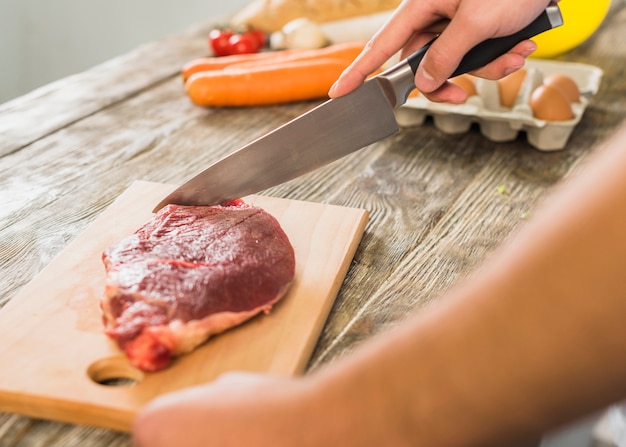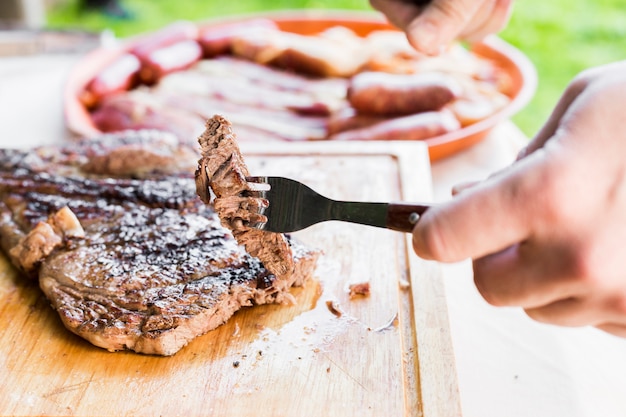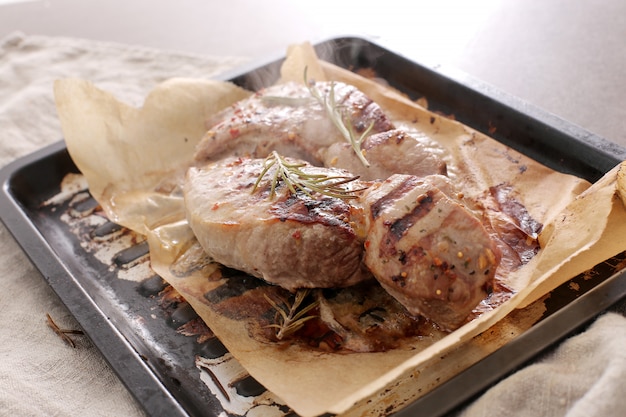There's something about a tomahawk steak that just screams "special occasion." Maybe it's the dramatic bone handle, or perhaps the sheer size of the thing, but it definitely makes you feel like you're in for a treat. And let's be honest, a good steak is always a treat, right?
Over the years, I've cooked countless steaks, and I've had my fair share of triumphs and disasters. But I've learned a thing or two along the way, and I'm ready to share my secrets for achieving that perfect, juicy, melt-in-your-mouth tomahawk steak.
So, grab your apron, gather your kitchen tools, and let's get started on this epic culinary adventure!
(Part 1) The Tomahawk: A Beefy Beauty

Choosing the Perfect Cut
First things first, you need to choose your weapon... I mean, your steak. When it comes to tomahawk steaks, you're usually looking at a bone-in ribeye, renowned for its rich marbling and delicious flavour. Now, I'm not going to lie, these bad boys can be a bit pricey, but trust me, they're worth every penny.
You'll want to look for a steak that's at least 1.5 inches thick, with good marbling throughout. If you're feeling fancy, you can even go for a dry-aged steak, which is aged for a longer period and develops a deeper, more concentrated flavour. Dry-aging can add a slightly nutty, almost cheesy, aroma and a more tender texture.
Getting the Right Size
Speaking of size, let's talk about that impressive bone handle. It's not just for show, it actually helps to keep the steak moist during cooking. The bone acts as a natural heat conductor, drawing heat away from the steak's centre while simultaneously protecting the edges from overcooking. But it also means you need to plan ahead when it comes to oven space. I've learned the hard way that a regular oven rack might not be big enough for a large tomahawk, so you might need to use a roasting rack or even invest in a larger oven. If you find yourself with a very large tomahawk, you might even consider cooking it on a grill for a more even cook.
(Part 2) Prep Work: The Foundation for Success

The Power of Patience: Resting the Steak
Don't be tempted to jump straight into cooking! Patience is key, especially with a tomahawk. You want to give the steak time to come to room temperature before you even think about searing it. This helps ensure even cooking and prevents the steak from being cold in the middle, which can lead to uneven cooking and a less juicy result. I usually aim for at least 30 minutes, but an hour is even better.
Seasoning: A Symphony of Flavors
Now, this is where you get to be creative. I like to keep it simple with a good quality kosher salt and freshly ground black pepper. The salt draws out moisture from the steak, which helps to create a flavorful crust, while the pepper adds a subtle bite. But don't be afraid to experiment with other spices like garlic powder, paprika, or even a touch of chili flakes.
Personally, I like to create a little rub with a mixture of smoked paprika, onion powder, garlic powder, and a pinch of cayenne pepper. It adds a beautiful depth of flavor without overpowering the natural taste of the steak. Just remember, less is more when it comes to seasoning. Too much seasoning can overwhelm the delicate flavor of the steak.
A Quick Dip in Oil: The Secret to a Crispy Crust
Before you hit the pan, you want to make sure your steak is coated in a thin layer of oil. This helps create a crispy crust and prevents the steak from sticking to the pan. I prefer to use a neutral oil like grapeseed or avocado oil, but you can also use olive oil if you like. Just make sure it's a high-heat oil that won't smoke or break down at high temperatures.
(Part 3) The Searing: A Culinary Dance

Setting the Stage: The Hot Pan
Now comes the fun part. You need a really hot pan, and I mean really hot. Cast iron is your best bet here, because it retains heat well and gives you a nice even sear. Heat it over high heat for about 5 minutes, until it's smoking hot. If you don't have a cast iron pan, you can use a heavy-bottomed stainless steel pan, but it may not get as hot.
The Art of Searing: Getting It Right
Carefully place your steak in the hot pan and let it sear for about 2-3 minutes per side. Don't move it around too much, you want to let that beautiful crust develop. The sear helps to lock in the juices and create a flavorful crust. I like to sear each side, then the top and bottom, for a truly beautiful finish.
The Importance of Patience: Resist the Urge to Flip
Here's the thing: you want to resist the urge to flip the steak too often. I know it's tempting, but you want to give it time to get a nice crust. Don't worry, it won't stick to the pan if you've oiled it properly and let it sear for a bit. Trust me, patience is key! If you flip the steak too often, you'll end up with a less flavorful crust and a steak that's not cooked evenly.
(Part 4) The Oven: Bringing it Home
Preheat and Protect: Setting the Stage
Once you've seared your steak, it's time to finish it in the oven. Preheat your oven to the desired temperature. I usually go for 350°F (175°C), but you can adjust this depending on your preferred level of doneness. A higher temperature will result in a faster cook time, while a lower temperature will give you a more evenly cooked steak.
The Right Rack: Ensuring Even Cooking
You'll want to place your steak on a roasting rack over a baking sheet. This allows hot air to circulate around the steak, ensuring even cooking. It also helps catch any juices that drip from the steak, which you can later use to make a delicious pan sauce. If you don't have a roasting rack, you can place the steak directly on the baking sheet, but make sure to turn it halfway through cooking to ensure even cooking.
Time to Relax: Letting the Steak Rest
Now, here's where patience really comes in. You want to let the steak rest in the oven for about 10-15 minutes, depending on the thickness of your steak and your desired level of doneness. This allows the juices to redistribute throughout the steak, ensuring a tender and juicy result. The longer you let the steak rest, the more tender and juicy it will be.
(Part 5) The Big Reveal: Checking the Doneness
The Ultimate Test: Using a Thermometer
I'm a firm believer in using a meat thermometer to ensure your steak is cooked to your liking. Using a thermometer is the most accurate way to determine the doneness of your steak. You want to aim for a temperature of 130°F (54°C) for medium-rare, 135°F (57°C) for medium, and 140°F (60°C) for medium-well.
The Look and Feel: Reading the Signs
If you don't have a thermometer, you can also judge the doneness by the appearance and feel of the steak. A medium-rare steak will have a slightly pink center, while a medium steak will have a brown center. A well-done steak will have a completely brown interior. You can also press on the steak to test the doneness. A medium-rare steak will feel soft and springy, while a well-done steak will feel firm.
(Part 6) Resting and Slicing: The Final Touches
The Patience Pays Off: Letting the Steak Rest
Once the steak is cooked to your liking, remove it from the oven and let it rest for 10-15 minutes before slicing. This allows the juices to redistribute throughout the steak, resulting in a more tender and flavorful cut. Letting the steak rest also allows the internal temperature to even out, ensuring that the steak is cooked evenly throughout.
Slicing Perfection: Showcasing the Beauty
Now, it's time to slice your tomahawk steak. I like to cut it against the grain, which helps to tenderize the meat and makes it easier to chew. Cutting against the grain means slicing across the muscle fibers, which makes the meat more tender and less chewy. And don't forget about the bone! You can use a meat cleaver or a sharp chef's knife to cut through it.
(Part 7) The Sides: Complementing the Star
Balancing Flavors: The Art of Accompaniment
A tomahawk steak is a pretty hefty meal, so you don't want to overpower it with heavy sides. I like to keep things simple with a few classic accompaniments.
Classic Choices: potato gratin, Creamed Spinach, and a Green Salad
Here are a few of my go-to side dishes:
Potato Gratin: A creamy, cheesy potato gratin is a perfect complement to the richness of the steak. The creamy texture of the gratin contrasts nicely with the tender steak, while the cheese adds a touch of richness.
Creamed Spinach: This classic side dish adds a touch of freshness and lightness to the plate. The bright green color of the spinach contrasts beautifully with the brown steak, and the creamy sauce adds a touch of richness without being too heavy.
Green Salad: A simple green salad with a light vinaigrette is a refreshing and healthy addition. The salad helps to cleanse the palate between bites of the steak, and the vinaigrette adds a touch of acidity that cuts through the richness of the meat.
(Part 8) The Pan Sauce: A Touch of Magic
The Essence of Flavor: Transforming Drippings
If you're feeling ambitious, you can make a delicious pan sauce to accompany your tomahawk steak. The best part? You're using the flavorful drippings from the steak!
Simple Steps: Deglazing and Flavoring
Here's how to do it:
1. Pour off any excess fat from the pan.
2. Add a splash of red wine or broth to the pan and scrape up any browned bits from the bottom. This process is called deglazing, and it helps to release the flavorful fond, or browned bits, from the bottom of the pan.
3. Bring the mixture to a boil and reduce until it thickens slightly. This process concentrates the flavor of the sauce and creates a silky texture.
4. Stir in a tablespoon of butter and season with salt and pepper to taste. The butter adds richness and shine to the sauce, while the salt and pepper balance the flavors.
(Part 9) The Presentation: A Feast for the Eyes
A Final Touch: Garnishing the Plate
You've gone through all the effort, so why not showcase your culinary masterpiece? I like to present my tomahawk steak on a simple white plate with a few sprigs of fresh rosemary or thyme. These herbs complement the flavor of the steak and add a touch of elegance to the presentation.
A Table Worthy of Royalty: Setting the Scene
Don't forget to set the table for your special meal. A crisp white tablecloth, elegant silverware, and a few candles will create the perfect ambiance. The setting should reflect the occasion and enhance the dining experience.
(Part 10) FAQs: Your Tomahawk Steak Questions Answered
Q: What's the best way to cook a tomahawk steak to medium-rare?
A: The best way to cook a tomahawk steak to medium-rare is to sear it in a hot pan, then finish it in the oven at 350°F (175°C) for about 10-15 minutes. Use a meat thermometer to check the internal temperature, aiming for 130°F (54°C). This method ensures that the steak is cooked evenly throughout and achieves the desired level of doneness.
Q: Can I cook a tomahawk steak in a cast iron skillet?
A: Yes, you can definitely cook a tomahawk steak in a cast iron skillet. In fact, it's a great option because cast iron retains heat well, which is essential for getting a good sear. Just make sure your skillet is large enough to accommodate the steak. If you don't have a cast iron skillet, you can use a heavy-bottomed stainless steel skillet, but it may not get as hot.
Q: How do I prevent my tomahawk steak from drying out?
A: To prevent your tomahawk steak from drying out, be sure to let it come to room temperature before cooking and cook it over medium-high heat. Don't overcook it, and be sure to let it rest for 10-15 minutes before slicing. These steps help to ensure that the steak is cooked evenly and retains its moisture.
Q: What are some good side dishes to serve with a tomahawk steak?
A: Some good side dishes to serve with a tomahawk steak include potato gratin, creamed spinach, a green salad, asparagus, roasted brussels sprouts, and roasted vegetables. These sides complement the richness of the steak and add a touch of variety to the meal.
Q: How do I store a tomahawk steak?
A: Store a tomahawk steak in the refrigerator for up to 3 days. Wrap it tightly in plastic wrap or aluminum foil to prevent freezer burn. You can also freeze a tomahawk steak for up to 3 months. To freeze, wrap it tightly in plastic wrap and then aluminum foil. Freezing the steak will help to preserve its quality and freshness for a longer period.
(Part 11) Conclusion: The Tomahawk Experience
A tomahawk steak isn't just a meal, it's an experience. It's a celebration of good food, good company, and the art of cooking. It's a dish that commands attention and creates memories. So, next time you're looking to impress your guests or treat yourself to something special, give a tomahawk steak a try. I promise, you won't be disappointed.
Now, go forth and cook! And remember, don't be afraid to experiment and find what works best for you. The best cooks are the ones who are willing to try new things and learn from their mistakes. Happy cooking!
Everyone is watching

Corn on the Cob: The Ultimate Guide to Perfectly Cooked Ears
Healthy MealsAh, corn on the cob. Just the name evokes images of sunny days, barbecues, and that sweet, juicy flavour that ...

Perfect Pork Roast Oven Cooking Time: A Guide to Delicious Results
Healthy MealsThere's something truly satisfying about a perfectly roasted pork. The aroma alone is enough to make your mout...

Ham Cooking Time: How Long to Bake, Smoke, or Boil a Delicious Ham
Healthy MealsAh, ham. It's a classic, isn't it? A real crowd-pleaser, especially around holidays. And when done right, it'...

Scallops: The Ultimate Guide to Perfect Cooking
Healthy MealsAh, scallops. Those delicate, sweet, and utterly delicious morsels of the sea. They hold a special place in my...

Spaghetti Squash: The Ultimate Guide to Cooking and Serving
Healthy MealsRemember that time you saw spaghetti squash at the supermarket, looking all bumpy and strange, and thought, "W...
